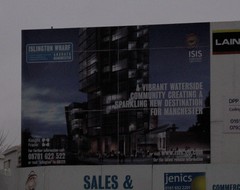I can’t really add much to this excellent article in the Guardian, based on a Manchester blog:
The RenterGirl blog, a heartfelt account of life as an urban nomad
The blog itself has far more gruesome details.
To the outsider most of the urban housing developments look similar and are advertised with the same imagery of sleek stylish models, so it’s easy to assume what they’re like to live in, and who lives there. In most cases this impression is wrong. Most developers also seem to seem to assume that residents have a lifestyle and requirements that simply don’t exist in any real way.
Hundreds of flats have been built that don’t suit real life at all. Nowhere to keep a suitcase. Nowhere to put a bin. Nowhere to dry clothes. I viewed one flat that had two tiny bathrooms but nowhere to put a television, and one where no windows opened and the only ‘fresh’ air was from a single pipe emerging from the ceiling. Flats without ovens, with nowhere to dry dishes, or nowhere to store dishes. Whole blocks where the combined moisture from drying clothes and cooking makes the building tropicaly humid, almost stifling.
There are blocks of big-name-designed apartments in Manchester where the corridors are spotted with dog shit and one bedroom flats cost £150,000. In the last flat we rented we had the luxury of mushrooms growing in the corridor, damp, dodgy wiring, deafening 24 hour parties and rubbish bags left in the foyer and on stairways.
Manchester Council likes to talk of Manchester becoming more like a European city, but most European cities have a mixed population in the city centre. Almost every development in Manchester is chasing the same section of the market. There’s little room for people wanting to live in the city for the long term, rather than just stay for a few years before moving to Chorlton. There’s nothing for families and little for elderly people. There’s a shortage of GPs and don’t even try to find a children’s playground.
It’s not all bad. The problem blocks are usually those with a high number of landlords and short-term renters. Renters themselves are usually fine, but there’s often a big enough percentage of bad renters (and bad landlords) to damage life for everyone else. Flats that can’t be lived in as homes, or for long periods, attract people who don’t live “normally”, or socially, and who don’t give a damn about the area or neighbours because they’ll be moving on. Many blocks effectively become unmanaged halls of residence for the recently graduated (or even wealthy students). No one plans to stay long, few people care about where they live. The term “Neverland” used by RenterGirl is very appropriate. It only takes a few people without a conscience to ruin things for everyone else. I should add that blaming bad residents is only half the story: I think bad landlords are the root cause of the problem.
Not everyone living in the city centre is like that, and not all developments are equally troubled. Many older developments tend to be less shiny but much less intensive, with functioning communities and much more respect (there’s a topical buzzword…). I think that indicators of better developments can include:
* The more owner-occupiers the better.
* Built in the 1980s or 1990s and still surviving more or less intact.
* Wider than it’s tall.
* A big, strict set of rules for occupants.
* Self-managed or owned cooperatively.
* Low service charges can result in poor maintenance later on, although high charges can indicate something’s gone wrong.
* Be wary of upper floor flat’s if there’s only one lift. It will break.
* Flats of various sizes , with three bedroom properties that aren’t token/trophy penthouses. People in larger flats tend to stay longer.
* Few for-sale signs. People don’t want to leave the better places.
* New buyers tend to be attracted by the new developments, so the better/older places are often no more expensive
* The management fund should be growing
* If a recent developer, check the list of outstanding problems submitted to developers: the shorter the better.
* Check how responsive the management agency is: leaking pipes fixed immediately is not so bad, they could be left for months…
We were rather impressed with what we saw of Granby Village in the city centre (we failed to get a place there) and we’re now very happy with Piccadilly Village. The little Smithfield estate in the Northern Quarter also interested us, but very few of the properties were for sale (some are probably still Council owned, however).
I hope that over time the developments with problems grow established communities as some sort of balanced ecosystem evolves, but in some cases whole buildings can reset: we visited one building that had become almost empty; most owners had deserted it, cutting their loses, and it was gradually being repopulated with hardy frontier settlers ready to repair both the water-damaged plasterwork and the community.
Community is key to all this. At a new development on Great Ancoats Street a sign proclaims “A thriving exciting community!”. Nobody has moved in yet. A community is more than just a collection of residents, and it isn’t built ready for sale.